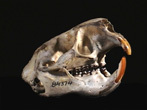Rodent jaws

Bringing the incisors together or using them to chisel away at a surface requires muscles that forcefully brings the lower jaw forward. In rodents, this is done primarily by the masseter muscle. Primitively, the masseter was divided into three portions: the masseter superficialis (), the masseter lateralis (), and masseter medialis or profundus (). In primitive forms, the superficial masseter arose near the anterior end of the toothrow (a bump that serves as the point of origin in many rodents is termed the masseteric tubercle) and inserted along the lower part of the mandible at the rear. The lateral masseter arose from the midportion of the zygomatic arch and also inserted along the bottom of the lower jaw towards its rear. The medial masseter was small, originating along the inside of the middle of the zygomatic arch and inserting on the mandible near the end of the molar toothrow. This condition is called and in living rodents, is seen only in aplodontias.
By moving the point of origin of parts of the masseteric musculature anteriorly, rodents gain both mechanical advantage and additional range of movement of the lower jaw. This change in the origin has happened in at least three different ways.
- In the condition, lateral masseter moves forward and attaches to the the front of the zygomatic arch where it meets the rostrum. The origin of the superficial masseter is also shifted forward, but the origin of the medial masseter does not change much. In sciuromorphs, the front of the zygomatic arch is developed into a large, distinctive (for a drawing of the arrangement of the masseter, click here). This condition is found in squirrels, beavers, geomyids, heteromyids, and a number of other families.
- In the condition, the infraorbital foramen, which runs from the anterior part of the orbit to the outside of the rostrum, becomes very large. Through it, part of a much-expanded medial masseter passes to originate on the side of the rostrum anterior to the zygomatic arch (for a drawing of the arrangement of the masseteric muscles in hystricomorphs, click here). This condition is found in porcupines (both New and Old World families), guinea pigs, jerboas, and a large number of other families.
- The third condition is the one. Probably arising from a sciuromorphous ancestral state, this condition includes the development of a zygomatic plate and shifting anteriorly of the lateral masseter, as in sciuromorphs. The infraorbital foramen is also moderately enlarged, and through it passes a slip of medial masseter (for a drawing of the arrangement of the masseteric musculature, click here). There is considerable debate over how these three conditions evolved. It is widely accepted, however, that at least some of them were achieved independently by more than one group of rodents.
Changes in the position of each part of the masseter are summarized in the following three drawings: superficial masseter, lateral masseter, medial masseter.
The morphology of the area of insertion of the masseter on the lower jaw also differs among groups of rodents. In the jaw, the angular process, which receives much of the the masseter, arises more or less in a line with the rest of the jaw -- that is, it originates in the same vertical plane that also includes the alveolus (socket) of the incisors. In a jaw, the origin of the angular process is distinctly lateral to this plane, and the angular process often appears to be flared laterally. The coronoid process is usually reduced in hystricognathous forms.
Rodent phylogeny and classification has been the focus of many disagreements, some of which continue. Our current best guess about the phylogeny of rodents, however, suggests that the difference in pattern of insertion of the masseter (sciurognathy vs. hystricognathy) reflects a deep phylogenetic division. Here, we follow Carleton (1984) in recognizing two suborders, the Sciurognathi and Hystricognathi. The myomorph and sciuromorph taxa are included in the Sciurognathi, while most hystricomorphs are in the Hystricognathi.
Contributors
Phil Myers (author).